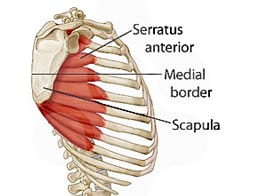 Last weekend I was teaching a Deep Massage Teacher training and we traded each day. On the second day, after receiving, I stood up, walked around, and was amazed at how free my shoulder girdle felt – primarily because my partner hadn’t worked on my shoulders!
Last weekend I was teaching a Deep Massage Teacher training and we traded each day. On the second day, after receiving, I stood up, walked around, and was amazed at how free my shoulder girdle felt – primarily because my partner hadn’t worked on my shoulders!
Neither of us could figure it out. Then the next morning we both shared our thought that the freedom stemmed from work up the side of the torso we’d done – particularly through serratus anterior.
A reminder – serratus anterior attaches to the “medial border” of the shoulder blade, then flows in front of the shoulder blade, between it and the ribs. It then attaches to the upper 9 or 10 ribs, via little musculo-tendinous “slips” that almost look like fingers. At those tips it “interdigitates” with the external oblique, one of your core abdominal muscles.
Serratus anterior helps pull your shoulder blades forward. Its attachments to the ribs in that case act as the origins and those “fingers” pull the medial border of the shoulder blades forward, in “protraction”. The serrati are quite active when you do the pushing up phase of the push-up; the scapulae move away from each other in a forward direction.
Serratus anterior can also be tight. In that case the attachment to the scapula can act as the origin and the ribs get pulled back, ultimately jamming the ribs they’re attaching to into the vertebrae.
In any case, my partner just did one or two passes with me in a side-lying position. Slowly going up the side of the ribs with curved fingers, he suggested length to the side of the torso and paused when encountering tissue tension or diminished breath movement.
We think this is what did it.
Serratus anterior, like so many muscles, lives in the realm of “sensori-motor amnesia”. It does its job with little complaint, rarely bringing attention to itself. Energetically it may be associated with reaching out or holding back. Freed, it can open up the lateral aspect of the heart and lungs and their associated emotions. And of course with my shoulders resting back on my ribcage, not being pulled forward, the sense of burden and collapse so commonly felt in the “yoke” of the shoulder girdle was deeply relieved – helping restore the wingéd, not the yoked feeling, of shoulder girdle, arms and hands.
When therapists pay attention to serratus anterior and the many other muscles and tensions that live largely below our awareness but affect us deeply, it can make an enormous and positive difference in our lives.

